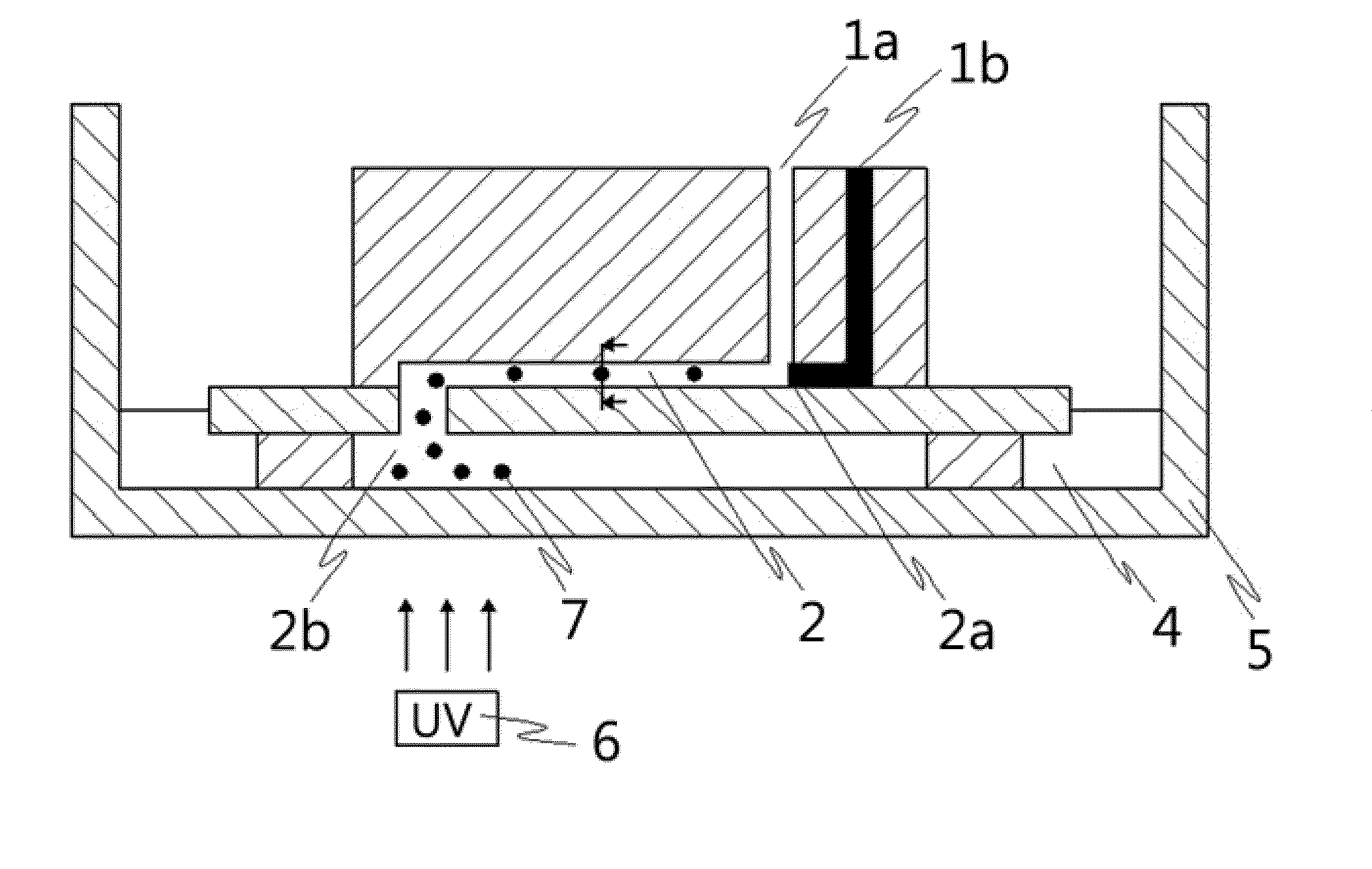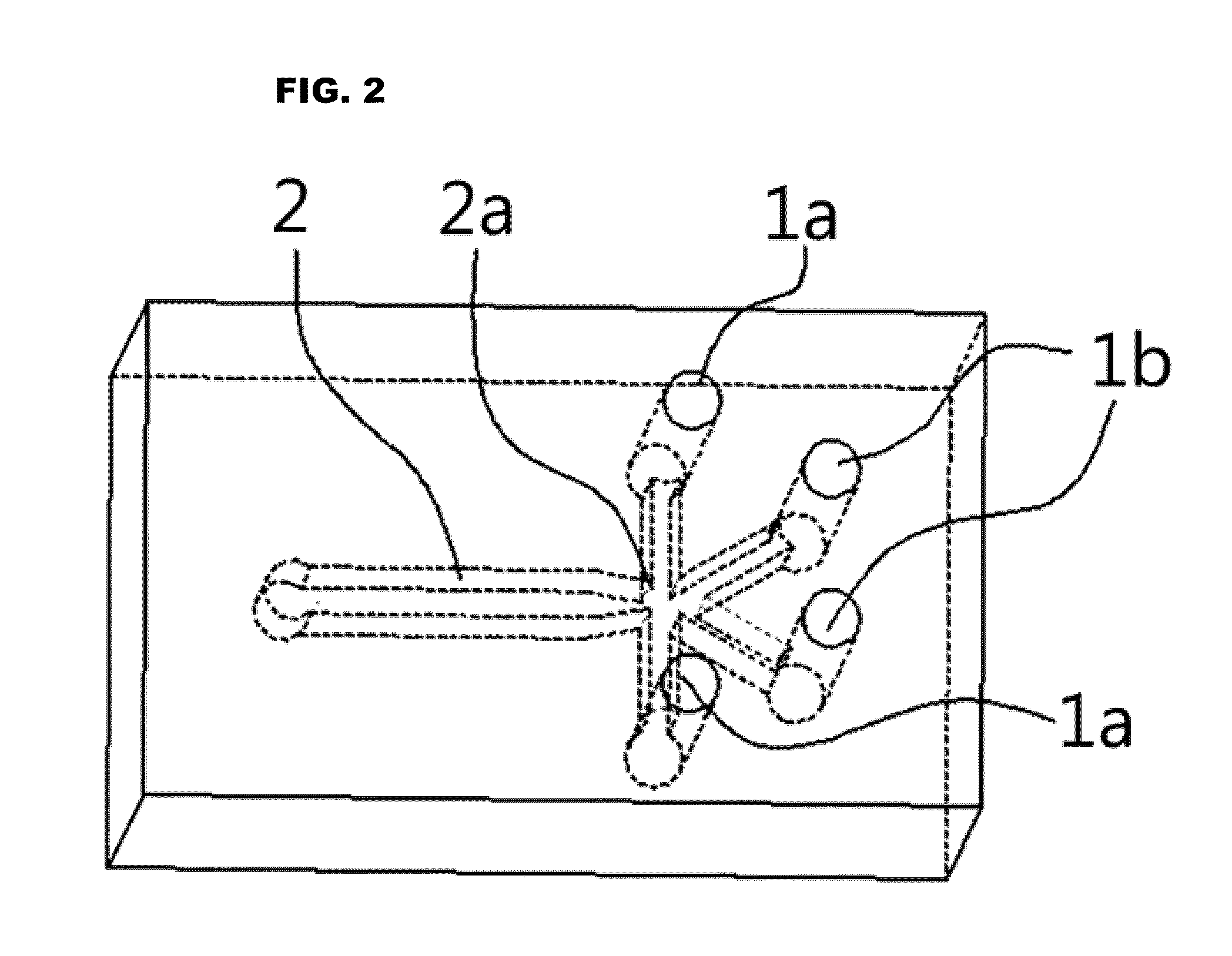Preparation method for micro-capsule using a microfluidic chip system
a microfluidic chip and microfluidic chip technology, applied in the field of preparation of microcapsules using a droplet-based microfluidic chip, can solve the problems of consuming a lot of time and cost, forming microcapsules of various sizes, and achieving the effect of simple preparation and convenient us
- Summary
- Abstract
- Description
- Claims
- Application Information
AI Technical Summary
Benefits of technology
Problems solved by technology
Method used
Image
Examples
example 1
Preparation of Microcapsules
[0045]Microcapsules were prepared using a droplet-based microfluidic chip having the structure and dimensions conceptually shown in FIGS. 3, 4 and 5. For UV irradiation, a 100 W HBO mercury lamp (OSRAM) equipped with a UV filter (11000v2: UV, Chroma) was used.
[0046]As a continuous phase, a hexadecane containing 5 wt % of 2,2-diethoxyacetophenone (DEAP) as a photoinitiator was selected, and as a monomer phase, an aqueous solution containing 20 wt % of N-isopropylacrylamide (NIPAM) as a monomer and 5 wt % of N,N-methylenebisacrylamide (BIS) as a crosslinker was selected.
[0047]As shown in FIG. 7, when the droplet-based microfluidic chip is used, if the dimensionless capillary number (Ca) indicating the relationship between interfacial tension and viscosity, and the volumetric flow rate of the monomer phase are used as variables, the production of stable droplets is possible in specific hydrodynamic boundary conditions. According to this data, the volumetric ...
example 2
Control of Diameter of Microcapsules
[0063](1) Control of Diameter of Microcapsules by Addition of Surfactant
[0064]In the process of preparing the microcapsules, a surfactant (SPAN 80) was added to the continuous phase, and the diameters of the microcapsules according to concentrations (1, 3 and 5 wt %) of surfactant added and volumetric flow rate of the continuous phase were examined (see FIG. 13). Herein, the volumetric flow rate of the monomer phase was set at 0.03 μl / min.
[0065]As can be seen in FIG. 13, the diameter of the microcapsules decreased as the volumetric flow rate of the continuous phase increased and the amount of surfactant added increased. Without being limited to a particular theory, this is thought to be because the interfacial tension between the continuous phase and the monomer phase decreases with an increase in the concentration of the surfactant, so that the fluid thread is slender, and at the same time, smaller droplets are induced by the shear force of the ...
application example
[0070]Microcapsules were prepared in the same condition and manner as in Example 1, except that material to be loaded was added to the monomer phase: (1) protein FITC-BSA (fluorescein isothiocyanate-conjugated bovine serum albumin; FITC (excitation / emission: 496 nm / 521 nm)) in an amount of 100 μg per ml of the monomer phase or (2) mercaptoacetic acid-capped quantum dots (excitation / emission: 595 nm / 610 nm) in an amount of 10 μg per ml of the monomer phase.
[0071]The prepared microcapsules were illuminated with UV light and photographed by fluorescence microscopy (see FIG. 15). As can be seen in FIG. 15, the protein-loaded microcapsules (FIG. 15A) and the quantum dot-loaded microcapsules (FIG. 15B) showed green fluorescence and red fluorescence, respectively, and no fluorescence was observed in the background. This suggests that the desired materials were effectively loaded into the microcapsules.
[0072]Thus, according to the method of the present invention, a desired drug or a biomole...
PUM
| Property | Measurement | Unit |
|---|---|---|
| Thickness | aaaaa | aaaaa |
| Thickness | aaaaa | aaaaa |
| Diameter | aaaaa | aaaaa |
Abstract
Description
Claims
Application Information
 Login to View More
Login to View More - R&D
- Intellectual Property
- Life Sciences
- Materials
- Tech Scout
- Unparalleled Data Quality
- Higher Quality Content
- 60% Fewer Hallucinations
Browse by: Latest US Patents, China's latest patents, Technical Efficacy Thesaurus, Application Domain, Technology Topic, Popular Technical Reports.
© 2025 PatSnap. All rights reserved.Legal|Privacy policy|Modern Slavery Act Transparency Statement|Sitemap|About US| Contact US: help@patsnap.com



